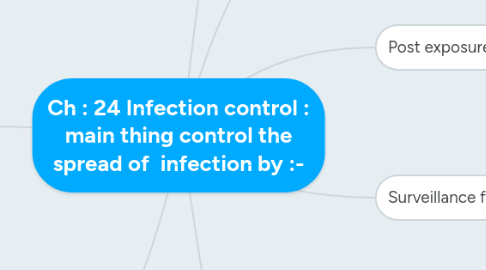
1. Nosocomial infection :
1.1. Known nosocomial infection
1.1.1. Ventilator associated pneumonia
1.1.2. Staphylococcus aureus.
1.1.3. Methicillin resistant Staphylococcus aureus (MRSA).
1.1.4. Candida albicans.
1.1.5. Pseudomonas aeruginosa.
1.1.6. Tuberculosis
1.1.7. Urinary tract infection.
1.1.8. Hospital-acquired pneumonia (HAP)
1.1.9. Gastroenteritis
1.1.10. VancomycinresistantEnterococcus (VRE).
1.2. Risk factors :-
1.2.1. Poor state of health , with immunodeficiency ( due to drugs / illness / irradiation
1.2.2. Invasive devices ex:- intubation tubes, catheters & surgical drain
1.2.3. A patient's treatment itself can leave them vulnerable to infection. Ex :- immunosuppression and antacid & antimicrobial therapy
2. Infection disease :-
3. Personal protective equipment
3.1. Special physical barrier clothes worn by the worker for protection against a hazard
3.2. The hazard is the health care sitting exposure to :
3.2.1. Blood
3.2.2. Saliva
3.2.3. Body fluid
3.2.4. Aerosols
3.2.4.1. May contain HIV and Hepatitis
3.3. PPE :
3.3.1. Gowns
3.3.2. Gloves
3.3.3. Bonnets /بطانيات
3.3.4. Shoes cover
3.3.5. Face shield
3.3.6. Surgery mask
3.3.7. Respirators
3.3.8. Goggles
4. Vaccines for health care worker
4.1. Vaccines do not give complete protection from disease
4.2. For hepatitis B
4.3. Influenza
4.4. Measls
4.5. Mumps
4.6. Tetanus
4.7. Diphtheria
5. Post exposure prophylaxis
5.1. We can use antibodies injection for HIV-AIDs within 4 hours of significant exposure
6. Surveillance for emerging infections / مراقب العدوى
6.1. Determining infection be by ( ICP ) infection control practitioner
6.2. Need to review the patient chart , observation if the patient have signs and symptoms of infection
6.3. Cover infection of the :
6.3.1. Blood stream
6.3.2. Urinary tract
6.3.3. Pneumonia
6.3.4. Surgical site
7. Isolation : various measures designed to prevent the spreading of infection , to health personal/ client / visitors
7.1. Category specific isolation
7.1.1. Strict isolation
7.1.2. Contact isolation
7.1.3. Respiratory isolation
7.1.4. Enteric isolation
7.1.5. Drainage / secretion isolation
7.1.6. Blood / body fluid isolation
7.1.7. Tuberculosis isolation
7.2. Disease specific isolation
7.2.1. Provide precaution :
7.2.1.1. Standard precaution
7.2.1.1.1. 1-perform proper hand hygiene after contact with blood, body fluids, non intact skin & mucus membrane.
7.2.1.1.2. 2-wear clean gloves when touch blood, body fluids and contaminated materials
7.2.1.1.3. 3- wear mask, eye protection or face shield if expecting splash of any material.
7.2.1.1.4. 4-wear clean non-sterile gown if expecting splashes or spry of materials.
7.2.1.1.5. 5-handle client care equipment that's is soiled with any material carefully prevent the transfer of m.o in to environments
7.2.1.1.6. 6-handle, transport& process linen in a manner to prevent contamination of clothing
7.2.1.1.7. 7- prevent injuries from used scalpels, needles, or other equipment.
7.2.1.2. Transmission based precaution
7.2.1.3. Droplet precaution
7.2.1.4. Contact precaution
7.2.2. Using same ppe , and depends on use of private room with ventilation
